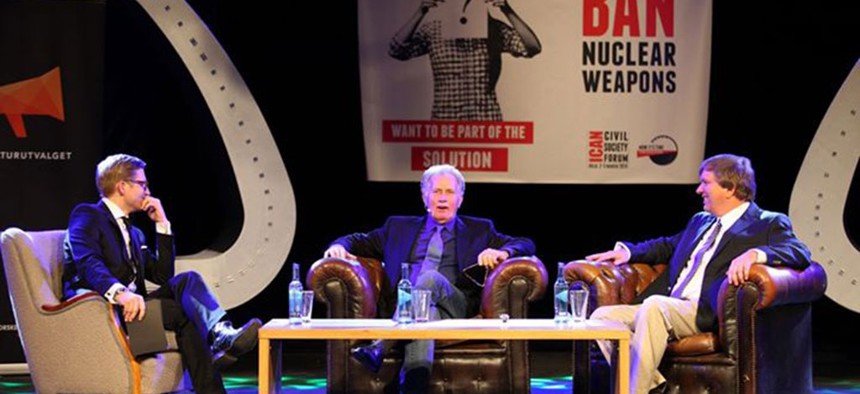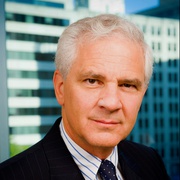
Actor Martin Sheen speaks at the ICAN Civil Society Forum in Oslo, Norway, on March 3, 2013. ICAN
Vienna Conference Could 'Change the Calculus' of US Nuclear Policy
The anti-nuclear weapons movement is modernizing, too, and policy makers should notice. By Joe Cirincione
VIENNA, Austria -- While Iran negotiations get screaming headlines, recent conferences on the consequences of the use of nuclear weapons have not gotten much attention. Maybe they should. They are generating a growing movement that could have a bigger impact on U.S. nuclear policy than many have assumed.
Most security analysts were only dimly aware, if at all, that a conference on the humanitarian impact of nuclear weapons was held in Oslo, Norway, in March 2013, then a second conference, somewhat larger, in Nayarit, Mexico, in February 2014. I personally did not pay much attention -- and nuclear policy is my job.
But a third Humanitarian Impact of Nuclear Weapons conference is underway this week in Vienna that could be changing the calculus. It is the largest yet, with 800 delegates from almost 160 nations. I am attending for the first time, as are dozens of my colleagues. More importantly, the United States has sent an official delegation, as have the United Kingdom, India and Pakistan. This is a first for the nuclear-weapon states, who shunned the previous discussions.
The grand, historic Hofburg Palace is filled with officials and scores of nongovernment groups who jam the galleries and mingle in the hallways debating strategies. The nongovernment groups held a separate “civil forum,” sponsored by the International Campaign to Abolish Nuclear Weapons, or ICAN, in the two days preceding the official conference. It was packed with over 600 participants, with most in their twenties and thirties.
There’s clearly something happening here, but, as Buffalo Springfield said, “What it is, ain’t exactly clear.” The ICAN conference pushed a new treaty to ban the bomb. The official Vienna conference does not have that goal, in part, because the U.S. and the nuclear-weapon states strongly oppose it. It is uncertain how many nations favor a new treaty, but they are searching for new ideas, new initiatives – something that can jump-start the moribund efforts to reduce nuclear dangers.
Speaker after speaker at the conferences warn of the dangers of keeping 16,000 nuclear weapons in fallible human hands 25 years after the end of the Cold War. The use of one modern nuclear weapon would be a catastrophe many times worse than Hiroshima and Nagasaki, triggering global economic turmoil. The use of a dozen would be destruction never seen before in human history. The use of just one hundred in a regional war would trigger a nuclear winter that could starve one billion people. A global nuclear war would be the end of human civilization.
Nuclear risks are growing, the speakers warn, from increased risk of accidents and miscalculation, from tensions in South Asia, from new nuclear use doctrines in Russia. Worse, they say, nearly every one of the nine nations with nuclear weapons is modernizing their arsenal. The United States alone is on track to spend an estimated $1 trillion on nuclear weapons over the next 30 years.
(Related: This Is a Pivotal Moment for the US Nuclear Arsenal)
Such “spending on nuclear weapons squanders the wealth of nations,” Pope Francis said in a statement to the conference. The Catholic Church has long opposed nuclear weapons, but had accepted the policy of deterrence during the Cold War. This week, however, the Pope said that threatening to use nuclear weapons, even to prevent others from using them, is no longer justifiable. “Nuclear deterrence and the threat of mutually assured destruction cannot be the basis for an ethics of fraternity and peaceful coexistence among peoples and states,” he said. Nuclear weapons must be “banned once and for all.”
This may seem completely alien to defense experts in Washington and the capitals of other nuclear-weapon states. For many, nuclear weapons are an essential part of a national security strategy. They hesitate to reducing their arsenals, least they appear weak to their adversaries or political opponents, even though few imagine actually using the weapons.
But what if they were used? What would happen? “We believe the world needs to know more about the devastating consequences of nuclear weapons use,” over 100 experts and former global government leaders wrote in an open letter to the Vienna conference. “The risks pose by nuclear weapons and the international dynamics that could lead to nuclear weapons being used are under-estimated or insufficiently understood by world leaders.” Signers included former Senators Sam Nunn and Richard Lugar, Joint Chiefs Vice Chairman Gen. James Cartwright, ret., former British Ministers Margaret Beckett, David Owen and Des Browne, and this author.
The letter signers urged the conference delegates to move to a sustained public education effort on the “catastrophic consequences” of nuclear use. This may well happen. A fourth “impact” conference is already planned. New films, reports, panels and citizen actions are in the works. Some groups are eager to follow the model of the successful land mine ban treaty, which began with a few states signing and snowballed into an effective global pact. The organizers of these conferences are encouraged by their success, excited by their potential, and angry at what they see as the failure of many elected leaders to do anything about the real and present nuclear dangers.
Call it part of the “we don’t trust government” movement. Or see it as a revival of the anti-nuclear movements of the 1950’s or 1980’s. Or think of it as nuclear Paul Revere’s racing to warn of coming threats.
Whatever you think, the Vienna conference signals the maturing of a new, significant current in the nuclear policy debate. Government policy makers would be wise to take this new factor into account.





